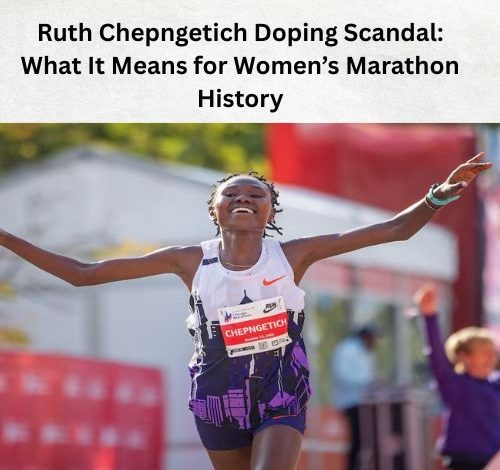Ruth Chepngetich Doping Scandal: What It Means for Women’s Marathon History

1. Introduction
On July 17, 2025, the Athletics Integrity Unit (AIU) announced the provisional suspension of Kenyan marathoner Ruth Chepngetich, following a positive test for hydrochlorothiazide (HCTZ)—a banned diuretic and masking agent—in a urine sample taken on March 14, 2025. Chepngetich had stunned the running world in October 2024, smashing the women’s marathon world record in Chicago with a time of 2:09:56, making history as the first woman ever to break the 2:10 barrier.
This development reverberates not just through her personal legacy but across the broader narrative of competitive excellence and trust in women’s marathon running. This article explores the timeline of events, technicalities of the doping violation, the potential consequences for Chepngetich’s records, and how this shakeup influences the history and future of women’s marathon.
2. From Record-Breaker to Suspension
2.1 The Meteoric Rise
Ruth Chepngetich, born August 8, 1994, in Kericho, Kenya, emerged as a dominant force in women’s marathon during her professional career, which began around 2016. Highlights include:
- 2019: Triumph at the World Marathon Championships in Doha—one of her earliest major titles.
- 2021–2022: Exceptional performances at Chicago and Nagoya marathons, including two back-to-back Chicago Marathon wins and a historic half‐marathon world record in Istanbul (1:04:02).
- October 2024: A performance for the ages—a 2:09:56 marathon in Chicago, obliterating the existing record (2:11:53). The effort placed her nearly two minutes ahead of the previous best.
The performance elicited both awe and skepticism. Some voiced concerns over the dramatic improvement, while others lauded her use of factors like advanced shoe technology and tailored fueling strategies—e.g., Maurten carbohydrate gels and Nike Alphafly shoes.
2.2 The Positive Test & Voluntary Suspension
Fast-forward to March 14, 2025: Chepngetich’s urine test revealed an abnormally high concentration of HCTZ—3,800 ng/mL, compared to the permitted threshold of 20 ng/mL. Though diuretics are banned primarily because they can mask other banned substances, they are broadly prohibited under WADA’s “S5” classification.
- April 3, 2025: Results reportedly received by the AIU.
- April 16: Chepngetich was interviewed in Kenya by AIU and later that week, around April 19, she voluntarily accepted a provisional suspension.
This voluntary suspension, though not mandated in cases involving diuretics/masking agents, aligned with AIU norms when athletes choose to respect the ongoing investigation.
2.3 AIU’s Formal Suspension & Notice of Charge
On July 17, 2025, nearly three months after her voluntary withdrawal from competition, the AIU issued an official Notice of Charge and implemented its own provisional suspension. Chepngetich is now awaiting a disciplinary tribunal, facing potential sanctions that could include a two-year ban—the standard penalty for specified substances when no compelling justification is made.
3. The Substance: Hydrochlorothiazide (HCTZ)
Hydrochlorothiazide is a thiazide diuretic prescribed medically for conditions like hypertension and edema. For athletes, its use is attractive for two main reasons:
- Rapid weight loss (making weight in sports like wrestling).
- Masking properties—it dilutes urine, potentially concealing other banned substances .
Given its inclusion under WADA’s “S5”, its presence at any trace level—even if not performance-enhancing per se—is penalizable . Chepngetich’s 3800 ng/mL result is almost 200x the permissible amount.
4. Rulebook Says: What Happens Next?
4.1 Provisional vs. Final Bans
Chepngetich now confronts multiple procedural layers:
- A provisional suspension, during which she cannot compete.
- A Notice of Charge, inviting her to defend herself before a tribunal .
- Possible punitive outcomes include:
- Up to two years of competition ban (for a specified substance like HCTZ), assuming no mitigating factors.
- If she proves no intent or contamination, the ban could be reduced—potentially to as low as six months, though unlikely at her elite level.
- The ban would likely be retroactive to April 19, when she voluntarily suspended herself.
4.2 Potential Impact on the World Record
An essential question looms: Will her 2:09:56 world record stand?
Under WADA rules, disqualification of results backdates to the sample collection date (March 14). Since the Chicago Marathon occurred before that (October 2024), the world record itself would likely remain intact, as there was no infraction within that calendar window.
Moreover, AIU statements confirmed the record is technically unaffected, though the court of public opinion may view it differently .
5. Historical Context: Doping’s Shadow Over Women’s Marathon
5.1 Brief History
Since gaining World Championship status in 1983, the women’s marathon has enjoyed iconic moments: Grete Waitz, Joan Benoit, Tegla Loroupe, Paula Radcliffe, Brigid Kosgei, and more recently Tigst Assefa, all pushed boundaries.
Yet doping scandals have periodically marred the sport:
- Paula Radcliffe—subject of late-career scrutiny, though she was never punished.
- Liliya Shobukhova—stripped of her 2010–2012 Chicago Marathon titles due to doping.
- Brigid Kosgei—also faced investigations, though never officially sanctioned.
Kenyan marathoners, in particular, have recently been embroiled:
- Kibiwott Kandie and Brimin Misoi Kipkorir were suspended.
- Sarah Chepchirchir faced a separate doping case.
5.2 The Kenyan Strain on Integrity
Kenya dominates distance running, producing a litany of Olympic champions and world record holders. The emergence of multiple doping cases in recent years—across genders and distances—has prompted:
- Internal safeguards by Athletics Kenya.
- Kenya’s government pledging $5 million annually toward enhanced anti-doping efforts.
Chepngetich’s case therefore strikes at the heart of Kenyan marathon prestige and raises questions about systemic oversight.
6. What This Means for Women’s Marathon History
6.1 Shaking Public Trust
Chepngetich’s case poses serious reputational risks:
- A record-breaking achievement later tainted invites comparison to earlier controversies (e.g., shock over Shobukhova, lingering doubt over Radcliffe, fear surrounding shoe tech).
- The timing—just weeks after the record-setting—renders doubts more intense and immediate.
6.2 Records vs. Reputation
Historical perspective shows sometimes a tainted athlete retains records (e.g., Ben Johnson’s stripped 1988 Olympic time), while in other cases records remain but legacy tarnishes. In Chepngetich’s case, her world record likely survives, but public trust won’t be as robust.
6.3 Broader Implications for the Sport
If the AIU and WADA respond affirmatively to this case—imposing a meaningful ban—it could:
- Serve as a deterrent, especially if it triggers scrutiny into other elite runners.
- Encourage clean athletes, both established and rising, to triumph without shortcuts.
Kenya’s investment in anti-doping and transparency in handling will be key.
7. Looking Ahead: Key Questions
| Question | Implication |
| How long will the ban last? | A 2‑year standard penalty could sideline her through the 2026–28 window, possibly ending her peak years. |
| Will she retain sponsorships? | Brands often distance themselves quickly; a conviction could endmare support. |
| Will the marathon record stand? | From a rule-based view, yes—but reputational stains linger. |
| Will this spur institutional change? | AIU, WADA, and Athletics Kenya may face increased pressure for reforms. |
8. Conclusion
Ruth Chepngetich’s rise from world champion to record-breaker par excellence was meteoric—a symbol of modern women’s marathon excellence. Yet this doping scandal complicates that narrative and raises difficult questions about trust, oversight, and the legacy of records.
Her 2:09:56 world record—the first time a woman broke 2:10—remains until proven invalid. But public confidence in the result may never fully recover.
Moving forward, the case underscores that:
- The fight against doping must be relentless, especially at elite echelons.
- Integrity—amid advancing gear, training, and physiology—must rely on transparent testing and enforcement.
- The story of women’s marathon history is unfinished: Ruth Chepngetich’s chapter will be a cautionary tale, reflecting both breathtaking achievement and the peril of unresolved suspicion.
Ultimately, women’s marathon will need to navigate these troubled waters—if only to ensure the feats of future champions stand without question, and the records they set inspire, rather than instigate, doubt.




